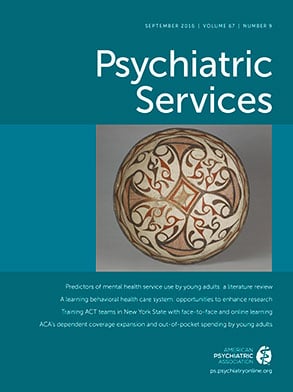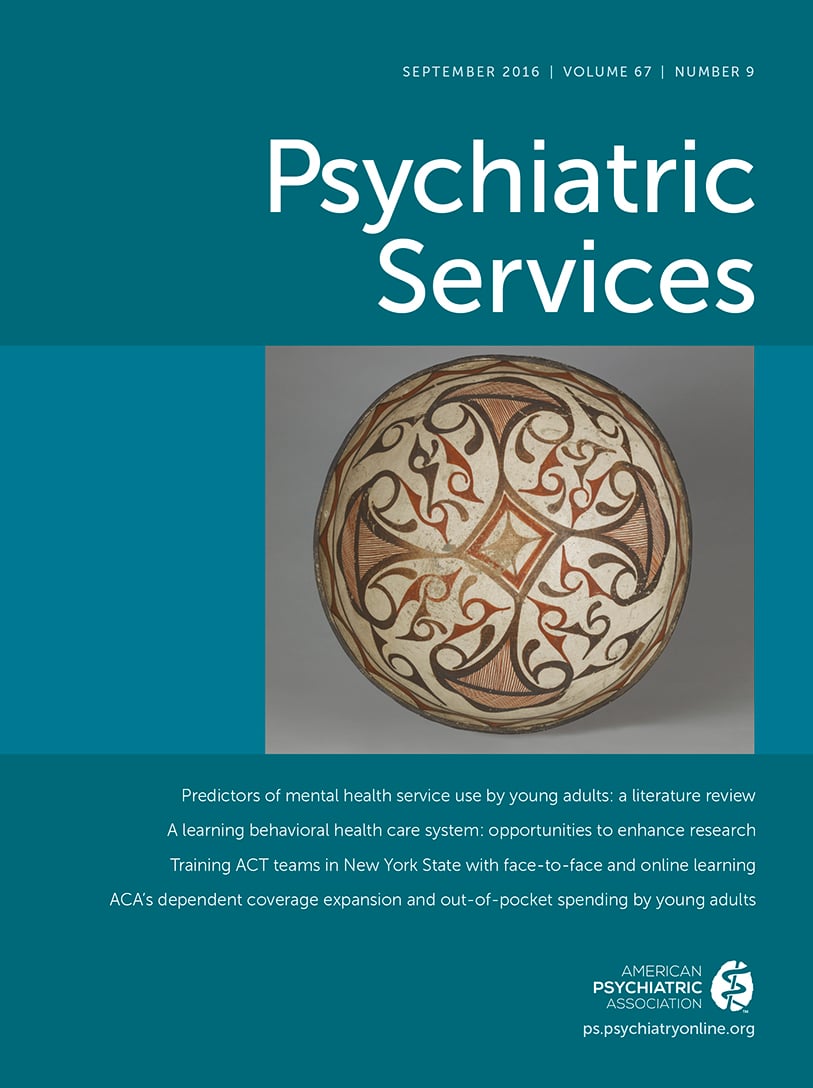Availability of Mental Health Services Prior to Health Care Reform Insurance Expansions
Abstract
Objectives:
Methods:
Results:
Conclusions:
Methods
Results
Psychiatrist Sample
| Characteristic | N | % | 95% CI |
|---|---|---|---|
| Age (M) | 56.7 | 56.0–57.4 | |
| Gender | |||
| Male | 711 | 65 | 62.0–67.8 |
| Female | 387 | 35 | 32.2–38.0 |
| Race-ethnicity | |||
| Non-Hispanic white | 776 | 82 | 79.6–84.6 |
| Asian | 76 | 8 | 6.6–10.2 |
| Hispanic | 41 | 5 | 3.4–6.2 |
| Non-Hispanic black | 40 | 4 | 3.2–5.9 |
| Other | 6 | 1 | .3–1.4 |
| Region | |||
| West | 259 | 24 | 21.1–26.3 |
| South | 239 | 24 | 21.1–26.3 |
| Northeast | 257 | 20 | 18.2–22.8 |
| Midwest | 200 | 17 | 15.3–19.7 |
| Mid-Atlantic | 144 | 15 | 12.9–17.5 |
| Primary psychiatry specialty | |||
| General | 829 | 75 | 72.6–77.9 |
| Child and adolescent | 234 | 21 | 19.0–24.0 |
| Psychoanalysis | 14 | 1 | .3–.7 |
| Addictions | 10 | 1 | .5–1.8 |
| Forensic | 9 | 1 | .5–1.9 |
| Workload in last typical workweek (M) | |||
| Patients treated | 45.3 | 43.2–47.5 | |
| Direct patient care (hours) | 34.3 | 33.4–35.2 | |
| Practice setting | |||
| Solo office | 361 | 34 | 33.9–39.4 |
| Outpatient clinic in a public hospital or freestanding facility | 192 | 18 | 15.5–19.7 |
| Group office | 214 | 20 | 14.2–18.4 |
| Outpatient clinic in a private hospital or freestanding facility | 80 | 7 | 5.4–8.1 |
| Inpatient unit in a public hospitalb | 60 | 6 | 5.3–8.0 |
| Inpatient unit in a private hospitalb | 55 | 5 | 4.1–6.3 |
| Other | 112 | 10 | 9.2–12.6 |
| Patients’ main source of payment | |||
| Private or commercial insurancec | 317 | 30 | 26.0–29.7 |
| Self-payd | 239 | 22 | 23.3–27.5 |
| Medicaid or CHIP, including Medicaid HMOse | 189 | 18 | 15.4–18.6 |
| Medicare, including Medicare HMOs | 155 | 14 | 11.5–13.7 |
| Other government or publicf | 117 | 11 | 10.1–13.5 |
| No charge or uncompensated | 23 | 2 | 1.8–2.7 |
| Other, including worker’s compensation | 14 | 1 | .8–1.6 |
| Don’t know | 23 | 2 | 1.2–2.8 |
Mental Health and Substance Use Treatment Availability
| Patients | ||||||
|---|---|---|---|---|---|---|
| Service | N | % | 95% CI | Nb | Mean | 95% CI |
| Psychotherapy | 374 | 36 | 33.2–39.8 | 313 | 13.6 | 10.9–16.3 |
| Housing | 324 | 32 | 29.0–35.5 | 275 | 9.4 | 7.4–11.4 |
| Supported employment | 304 | 31 | 27.4–33.8 | 247 | 12.7 | 9.7–15.8 |
| Case management or assertive community treatment | 304 | 30 | 26.9–33.2 | 260 | 8.4 | 6.4–10.5 |
| Alcohol or other substance use treatment | 304 | 30 | 26.5–32.8 | 256 | 7.2 | 5.9–8.5 |
| Inpatient mental health treatment | 204 | 21 | 18.6–24.3 | 179 | 5.5 | 4.0–6.9 |
| Psychosocial rehabilitation | 213 | 21 | 18.3–23.9 | 185 | 10.4 | 7.7–13.1 |
| General medical care | 201 | 20 | 17.6–23.3 | 181 | 11.8 | 9.1–14.6 |
| Psychopharmacologic treatment or psychiatric medications | 205 | 19 | 16.4–21.7 | 173 | 11.6 | 9.1–14.2 |
| Child and adolescent mental health assessment and treatment | 177 | 17 | 15.0–20.2 | 156 | 9.1 | 5.8–12.3 |
| Geriatric mental health assessment and treatment | 141 | 14 | 12.1–17.0 | 118 | 5.0 | 3.4–6.5 |
Ability to Spend Sufficient Time and Provide Enough Visits to Meet Patients’ Needs
| Patients | ||||||
|---|---|---|---|---|---|---|
| Practice type and constraint | N | % | 95% CI | Nb | M | 95% CI |
| Solo office (N=292) | ||||||
| Not enough time during the patient visit | 77 | 31 | 24.9–37.5 | 69 | 9.0 | 5.6–12.4 |
| Not able to provide enough visits to meet the patient's clinical needs | 70 | 25 | 19.9–31.6 | 56 | 7.3 | 4.9–9.7 |
| Group office (N=108) | ||||||
| Not enough time during the patient visit | 61 | 61 | 50.4–70.1 | 56 | 11.1 | 6.3–16.0 |
| Not able to provide enough visits to meet the patient's clinical needs | 36 | 34 | 24.6–43.8 | 31 | 10.5 | 3.7–17.4 |
| Public outpatient clinic (N=107) | ||||||
| Not enough time during the patient visit | 56 | 62 | 51.0–71.1 | 49 | 17.5 | 11.4–23.6 |
| Not able to provide enough visits to meet the patient's clinical needs | 44 | 46 | 35.4–56.9 | 36 | 13.9 | 9.0–18.9 |
| Total (N=1,099) | ||||||
| Not enough time during the patient visit | 493 | 52 | 48.7–55.5 | 441 | 12.8 | 11.1–14.5 |
| Not able to provide enough visits to meet the patient's clinical needs | 365 | 37 | 34.1–40.7 | 294 | 10.6 | 9.0–12.1 |
Psychiatrist Factors Associated With Treatment Availability Problems
| Characteristic | Inability to provide or arrange for servicesa | Insufficient time per visitb | Insufficient visitsb | |||||||||
|---|---|---|---|---|---|---|---|---|---|---|---|---|
| N | M | 95% CI | Mean diff. | N | M | 95% CI | Mean diff. | N | M | 95% CI | Mean diff. | |
| Age | ||||||||||||
| <40 | 110 | 3.2 | 2.7–3.7 | .73** | 109 | 7.3 | 3.7–10.8 | 1.58 | 107 | 3.7 | 1.9–5.5 | .79 |
| 40–49 | 185 | 2.9 | 2.4–3.3 | .40 | 172 | 6.1 | 3.9–8.3 | .37 | 171 | 4.2 | 2.7–5.6 | 1.28 |
| 50–59 | 333 | 2.8 | 2.5–3.2 | .36 | 315 | 7.2 | 5.2–9.2 | 1.49 | 308 | 3.8 | 2.5–5.1 | .89 |
| ≥60 (reference) | 455 | 2.5 | 2.2–2.7 | . | 433 | 5.7 | 4.4–7.0 | 419 | 2.9 | 2.0–3.9 | ||
| Gender | ||||||||||||
| Female | 380 | 2.7 | 2.4–3.0 | 361 | 5.7 | 4.5–6.9 | . | 347 | 3.3 | 2.3–4.3 | ||
| Male | 702 | 2.7 | 2.5–3.0 | .06 | 667 | 6.7 | 5.4–8.1 | 1.02 | 657 | 3.6 | 2.8–4.4 | .26 |
| Race-ethnicity | ||||||||||||
| Non-Hispanic white (reference) | 764 | 2.5 | 2.3–2.7 | 729 | 5.8 | 4.7–7.0 | 712 | 3.5 | 2.7–4.3 | |||
| Other | 162 | 3.4 | 2.9–3.8 | .81** | 154 | 9.5 | 6.2–12.8 | 3.67* | 151 | 4.5 | 2.8–6.2 | .96 |
| Region (states) | ||||||||||||
| Northeastern (reference) | 252 | 2.4 | 2.1–2.8 | 241 | 6.1 | 4.2–8.0 | 238 | 3.1 | 1.8–4.4 | |||
| Mid-Atlantic | 141 | 2.9 | 2.4–3.4 | .45 | 129 | 4.9 | 3.1–6.8 | –1.18 | 128 | 3.0 | 1.5–4.5 | –.08 |
| Midwestern | 197 | 2.8 | 2.3–3.2 | .34 | 183 | 7.2 | 4.6–9.8 | 1.08 | 180 | 4.7 | 2.5–6.8 | 1.59 |
| Western | 256 | 2.7 | 2.3–3.1 | .26 | 248 | 7.7 | 4.6–10.7 | 1.56 | 237 | 4.0 | 2.5–5.5 | .93 |
| Southern | 237 | 2.8 | 2.5–3.1 | .36 | 228 | 5.9 | 4.5–7.3 | –.23 | 222 | 2.9 | 2.1–3.7 | –.17 |
| Practice typec,d | ||||||||||||
| Solo practice (reference) | 370 | 2.2 | 1.9–2.4 | 355 | 3.8 | 2.1–5.5 | 348 | 1.9 | 1.3–2.6 | |||
| Group practice | 161 | 2.8 | 2.3–3.2 | .61* | 153 | 7.8 | 5.1–10.5 | 3.98* | 151 | 3.5 | 1.6–5.3 | 1.56 |
| Public outpatient clinic | 179 | 3.3 | 2.8–3.7 | 1.10*** | 169 | 8.9 | 6.3–11.4 | 5.07*** | 162 | 5.3 | 3.5–7.0 | 3.36*** |
| Other | 373 | 3.0 | 2.6–3.3 | .80*** | 352 | 6.9 | 5.4–8.4 | 3.14** | 344 | 4.2 | 2.9–5.5 | 2.29*** |
| Caseload >44 patientsc | ||||||||||||
| Yes | 448 | 2.9 | 2.7–3.2 | .59*** | 430 | 8.7 | 7.2–10.3 | 6.36*** | 419 | 4.7 | 3.7–5.7 | 3.25*** |
| No (reference) | 635 | 2.4 | 2.2–2.5 | 599 | 2.4 | 1.9–2.9 | . | 586 | 1.5 | 1.1–1.8 | ||
| >40 hours of direct patient carec | ||||||||||||
| Yes | 170 | 3.4 | 2.9–3.9 | .89*** | 163 | 9.9 | 7.0–13.0 | 4.71** | 159 | 5.6 | 3.5–7.6 | 2.68** |
| No (reference) | 909 | 2.5 | 2.3–2.7 | . | 862 | 5.2 | 4.3–6.1 | . | 842 | 2.9 | 2.3–3.4 | |
| Source of payment for ≥51% of patientsc | ||||||||||||
| Private insurance (reference) | 252 | 2.2 | 1.9–2.5 | 243 | 5.1 | 3.7–6.5 | 236 | 2.3 | 1.5–3.0 | |||
| Self-pay | 211 | 2.5 | 2.0–3.0 | .31 | 199 | 2.5 | 1.6–3.3 | –2.64*** | 196 | 1.9 | 1.1–2.7 | –.36 |
| Medicare | 40 | 2.2 | 1.5–3.0 | .04 | 38 | 4.5 | 2.1–6.8 | –.63 | 40 | 1.5 | .2–2.9 | –.75 |
| Medicaid | 136 | 3.0 | 2.5–3.5 | .82** | 129 | 6.0 | 4.0–8.0 | .91 | 128 | 3.9 | 2.2–5.5 | 1.62 |
| Other | 444 | 3.1 | 2.8–3.3 | .85*** | 420 | 8.9 | 6.9–10.9 | 3.81** | 405 | 4.9 | 3.6–6.3 | 2.66*** |
Discussion
Mental Health and Substance Use Services Availability
Psychiatrists’ Ability to Provide Sufficient Time and Visits
Strengths and Limitations of the Study
Conclusions
Footnotes
References
Information & Authors
Information
Published In

Cover: Bowl, interior, Zuni People, circa 1889. Painted terracotta MNC12330. Cité de la Ceramique, Sevres, France. Photo: Martine Beck-Coppola.
History
Authors
Funding Information
Metrics & Citations
Metrics
Citations
Export Citations
If you have the appropriate software installed, you can download article citation data to the citation manager of your choice. Simply select your manager software from the list below and click Download.
For more information or tips please see 'Downloading to a citation manager' in the Help menu.
View Options
View options
PDF/EPUB
View PDF/EPUBLogin options
Already a subscriber? Access your subscription through your login credentials or your institution for full access to this article.
Personal login Institutional Login Open Athens loginNot a subscriber?
PsychiatryOnline subscription options offer access to the DSM-5-TR® library, books, journals, CME, and patient resources. This all-in-one virtual library provides psychiatrists and mental health professionals with key resources for diagnosis, treatment, research, and professional development.
Need more help? PsychiatryOnline Customer Service may be reached by emailing [email protected] or by calling 800-368-5777 (in the U.S.) or 703-907-7322 (outside the U.S.).
